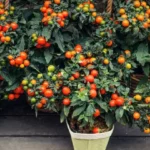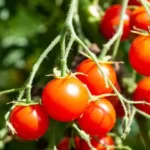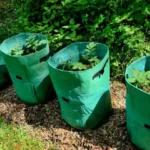When it comes to growing potatoes in containers in winter, you might be surprised by the possibilities that await. The challenge of nurturing these underground gems in a confined space during the colder months can be both rewarding and enlightening. As you navigate the intricacies of container gardening, addressing key factors such as temperature regulation, watering schedules, and soil composition will be essential.
Growing potatoes in containers during the winter months can be challenging, but it is possible with some considerations:
- Container Selection: Choose a large container with suitable drainage holes and insulating properties. Consider using a double-walled container or wrapping the container in insulating material to protect the potatoes from freezing temperatures over winter.
- Potato Selection: Select potato varieties for winter growing, such as late-season or cold-tolerant varieties. These varieties are more likely to withstand colder temperatures, primarily if you reside in a northern region.
- Soil Preparation: Use a well-draining, nutrient-rich potting mix for growing potatoes. Ensure the soil is well-aerated to prevent waterlogging, which can lead to rotting in cold conditions.
- Location: Place the containers in a sheltered area that receives maximum sunlight exposure during the day. Extra light during this time of year can help warm the soil and containers.
- Protection from Frost: Cover the containers with a frost cloth or blanket during freezing nights to protect the plants from frost damage. Remove the cover during the day to allow sunlight to reach the plants.
- Watering: Water the potatoes sparingly during winter. Although less frequent watering can occur over winter due to lower temperatures, watering during this time encourages beneficial soil microorganisms to remain in the soil. Ensure the soil is moist but not soggy.
- Harvesting: Harvest potatoes as needed during the winter months. The cool temperatures can help keep the harvested potatoes fresh for longer.
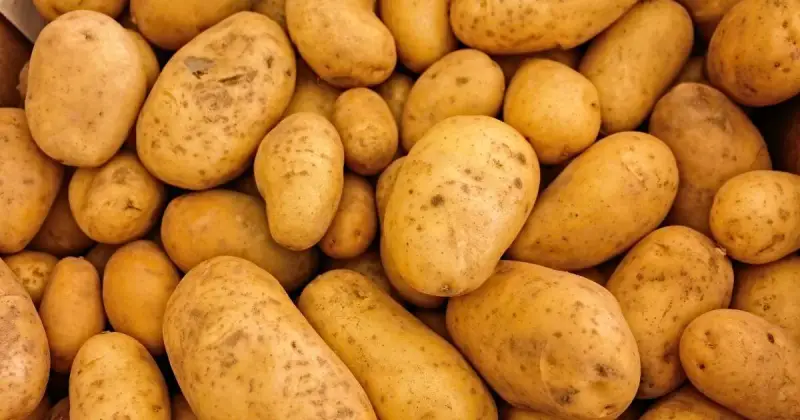
Growing potatoes in containers during the winter requires careful monitoring of temperature and moisture levels. You can grow potatoes in containers even during the colder months with proper care and attention. In this article, you’ll uncover insider secrets to help you succeed in this unique gardening endeavor while realizing the potential of fuller harvests with an extended growing season.
Humble Highlights
- Discover the right container size and potato variety that will offer the best chance of cultivating your spuds successfully over winter so you can make monitoring and caring for your plants more manageable, as they are more accessible and can be moved to more favorable locations.
- Save time by knowing how to sow your spuds for success with these 3 seed potato preparation steps so you can create and control the ideal growing conditions for your potatoes, such as soil type, moisture levels, and sun exposure, regardless of outdoor winter conditions.
- Stop guessing how to store your winter spuds and know with this done-for-you 6-step process that will help your potatoes last longer after harvesting so you can enjoy them throughout the season!
Choosing The Right Containers
When selecting containers for growing potatoes in winter, opt for those with good drainage to prevent waterlogging and root rot. Elevating the containers on pot feet or bricks can further facilitate drainage by preventing them from sitting in excess water. It’s also essential to use a well-draining potting mix and avoid heavy soils that can retain water.
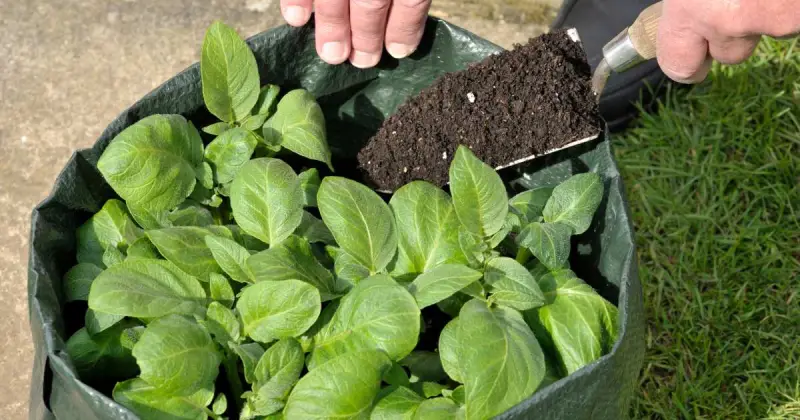
Choose containers at least 2-3 feet tall to accommodate the vertical growth of potato plants. Additionally, selecting containers with a 10-15 gallon capacity will provide enough space for the tubers to develop fully, providing the potential for maximum growth potential. Also, choose a container made of durable material, such as plastic or wood, that can withstand the harsh winter weather. 1
Depending on your regional temperatures, consider insulating the container with materials such as straw or bubble wrap to help protect the potatoes from freezing temperatures.
You’ll also want to place the container in a sheltered location with adequate sunlight to promote healthy growth and extra warmth, ensuring they have the best environment to thrive.
Selecting The Ideal Potato Varieties
When selecting potato varieties for winter container growing, opt for early season types like ‘Rocket’ or ‘Swift’ that flourish in confined spaces and have a shorter growing season. Choose varieties known for compact growth habits and resistance to diseases and pests to increase your chances of a successful container harvest. Consider the climate suitability and container space requirements to match the ideal potato variety with your winter growing conditions.
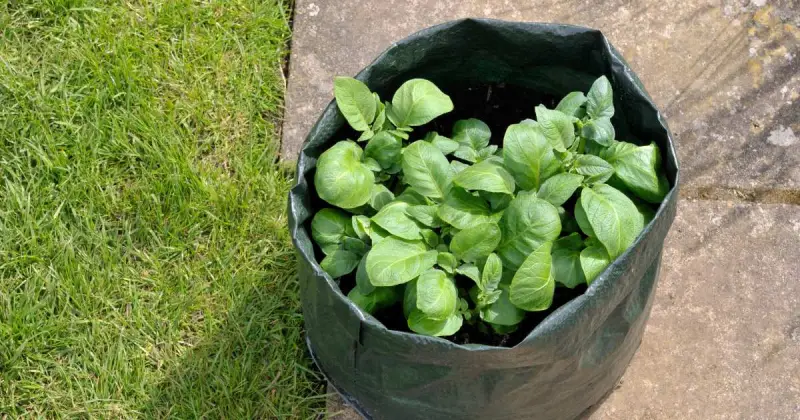
Best Potato Varieties
When selecting the ideal potato varieties to grow in winter containers, focus on early-season or first-early options like Rocket or Swift. These varieties are known for their compact growth and disease resistance. They are also high-yielding and perfect for container cultivation.
Additionally, before winter ends, look for potato types with shorter maturation periods, like Yukon Gold, Red Norland, and Warba. Opt for compact or bush-type varieties that thrive in limited spaces like containers. Choose potatoes renowned for producing well-formed tubers even in restricted soil volumes. 2
| Variety | Maturation Time | Type |
|---|---|---|
| Rocket | Early | Compact |
| Swift | First Early | Disease-resistant |
| Yukon Gold | Mid-season | High-yielding |
| Red Norland | Early | Compact |
| Charlotte | First Early | Disease-resistant |
Climate Suitability
For thriving potato cultivation in winter containers, select varieties like Charlotte or Maris Peer that are well-suited for colder temperatures and frost-resistant properties. These varieties are ideal for growing potatoes indoors in the winter.
When choosing potato types, consider your region’s specific climate conditions. Opt for early-maturing varieties that can develop quickly in cooler winter temperatures, like the ones previously mentioned. Frost-resistant potatoes are essential, as they can withstand colder weather and shorter daylight hours.
Consulting local gardening experts or nurseries can provide additional valuable recommendations on the best potato varieties for winter container growing in your area. By selecting the right potato varieties tailored to winter conditions, you can increase your chances of a successful harvest in your indoor container garden.
To keep your spuds warm during winter, techniques like using frost blankets, mulching heavily, and selecting sheltered planting locations can help protect potato plants from frost damage and allow them to thrive even in colder climates.
Additionally, planting potatoes earlier in the fall can give them a head start before the harshest winter weather sets in, increasing the chances of a successful winter harvest.
Container Space Requirements
To maximize the limited space in your containers for growing potatoes, select compact or dwarf varieties like Yukon Gold or Baby Boomer that can produce high yields efficiently. When choosing potato varieties for container gardening, consider options such as Caribe or Adirondack Blue, which are known for their ability to thrive and yield well in small spaces.
Opting for determinate potato varieties is another wise choice, as they only need a little room to spread their roots. Additionally, you can explore using vertical potato towers or stacked containers to maximize your container space. Remember to ensure that your containers are at least 10-15 gallons in size to provide adequate soil depth and room for potato growth.
Preparing The Potatoes For Planting
When preparing your potatoes for planting, chit (prepare) them under a grow light to encourage sprouting and healthy tuber growth. Cut the seed potatoes into pieces with at least two eyes per piece, allowing the cut surfaces to callus over before planting. Select high-quality potting soil and containers with good drainage for best growth.
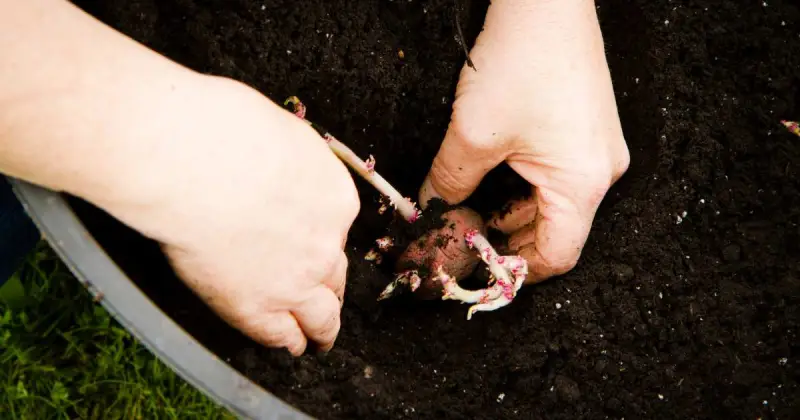
Seed Selection
When choosing seed potatoes for your winter container planting, consider the additional tips:
- Choose Certified Seed Potatoes: Choose certified seed potatoes over grocery store varieties to secure disease-free, high-quality seed stock.
- Look for Strong Sprouts: Healthy, vigorous sprouts indicate the seed’s vitality and readiness for planting.
- At Least Two Eyes: Select seed potatoes with at least two eyes per piece to encourage optimal growth and development.
Cutting Process
Allow the cut surfaces of the seed potatoes to callus over before planting to prevent potential rotting issues. This step is vital for the overall success of your potato crop and only takes an extra day or two. 3
Remember to plant the sprouted potatoes or the cut pieces with eyes to maximize your yield. Experienced gardeners highly recommend this cutting process to set the stage for a flourishing potato harvest.
Planting Process And Techniques
For successful potato growth in winter containers, ensure chitted potatoes are planted approximately two weeks before the average last frost date for your region. This timing is essential for the potatoes to establish their roots and start growing before the colder temperatures set in.
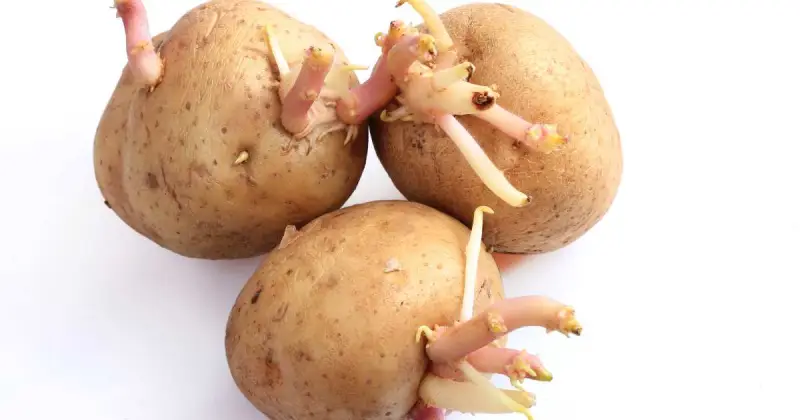
To help maximize your potato harvest, follow these fundamental techniques:
- Choose The Right Containers: Select containers at least 12 inches deep to allow for proper root development and offer excellent drainage.
- Use High-Quality Potting Soil: Invest in high-quality potting soil rich in nutrients to support the growth of healthy potato plants. Avoid using garden soil, as it may contain pests or diseases, lack vital nutrients, and may tend to compact, suffocating your plants by depriving them of necessary oxygen and water. 4
- Proper Spacing: When planting chitted potatoes in containers, space them adequately to allow room for growth. Plant them about 4-6 inches deep and 12 inches apart to give each plant enough space to thrive.
Providing Optimal Growing Conditions
Ensure sufficient sunlight for your container-grown potatoes during winter to optimize their growth. Potatoes thrive in full sun, so place your containers in a sunny spot to encourage healthy growth and extra warmth. If natural light is limited, consider bringing your spuds indoors and using a grow light to supplement the sunlight.
Of course, you’ll want to monitor the soil moisture regularly to keep it moist but not waterlogged over winter. Also, protect your container-grown potatoes from harsh conditions like frost and freezing temperatures. Insulate the containers with bubble wrap or fleece materials to shield them from the cold weather and help maintain ideal growing conditions. 5
Potatoes grown in winter can benefit from periodic ventilation, even in cold weather. While protecting the plants from harsh winter winds is essential, ensuring they receive fresh air can help prevent mold or fungal diseases. If growing potatoes indoors or in a greenhouse, opening windows or using a fan periodically to circulate air can help maintain a healthy growing environment. Removing any covers or barriers on mild days can also provide the necessary ventilation in outdoor settings. Check out the video below that details several important steps growers should follow for an excellent winter potato harvest.
Managing Challenges And Pests
When tackling unforeseen challenges and pests while growing potatoes in winter containers, vigilance is crucial to maintaining healthy plants. To effectively manage these issues, consider the following:
- Choose The Right Potting Mix: Make sure your potting mix is well-draining. A mix formulated explicitly for containers and vegetables can provide the necessary micro and macronutrients for your potato plants.
- Practice Organic Gardening: Embrace organic gardening practices to control pests and diseases naturally. Opt for methods like handpicking caterpillars or utilizing Neem oil to keep your plants healthy without harsh chemicals.
- Implement Physical Barriers: Protect your potato plants from common pests such as potato beetles using physical barriers like row covers. These barriers can prevent the pests from reaching your plants, reducing the chances of infestations, and may provide additional warmth as your plants mature. 6
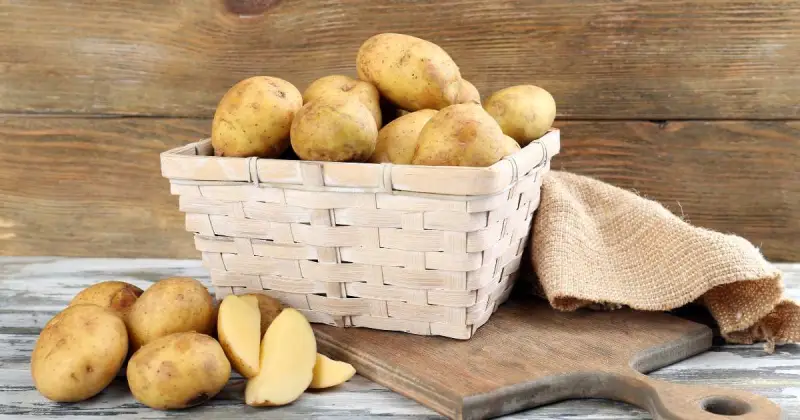
Monitoring And Caring For Potato Growth
Monitor your potato plants’ growth regularly by observing changes in leaf color, size, and overall plant health to ensure they’re thriving in their winter containers. As the plants have grown, look for any discoloration, which could indicate nutrient deficiencies or pest issues.
You’ll also want to check the size of the leaves and stems; healthy growth means vibrant green leaves and sturdy stems. Additionally, ensure the soil moisture remains consistently damp and adjust watering to maintain this environment. Protect your container-grown potatoes from frost by relocating them to a warmer spot during cold spells. 7
Watch for common pests that can harm your plants, such as potato beetles and caterpillars. If you notice any pests, take appropriate measures to eliminate them promptly.
In addition, support your potato plants as they reach a few feet tall to prevent them from bending or breaking. Consider using stakes or cages to support their physical growth and keep them upright.
One overlooked but important aspect of caring for potatoes over winter is adequate air circulation around the plants. In winter, the air tends to be more stagnant, creating a humid environment that can increase the risk of fungal diseases, such as late blight, especially in areas with fluctuating temperatures.
To improve air circulation, ensure that the containers are not placed too close together and that there is space between them for air to flow. Additionally, avoid overcrowding the plants within each container, impeding air circulation. Providing adequate air circulation can help reduce the risk of fungal diseases and promote healthier potato growth during winter.
Harvesting And Storing Potatoes
Harvesting and storing your potatoes can be rewarding and is crucial to ensure they remain fresh and flavorful for an extended period. Here are some practical tips to guide you through this stage:
- Harvesting: Wait until the potato plants’ foliage has died back before harvesting. Dieback indicates that the potatoes have reached maturity. Use a garden fork or shovel to gently loosen the soil and lift the potatoes from the ground. Be careful not to puncture or bruise the potatoes during harvest.
- Curing: After harvesting, allow the potatoes to cure for about two weeks in a cool, dark, and well-ventilated place, such as a cellar or garage. Curing allows the outer skin to toughen up, which helps prolong storage life.
- Storage Conditions: Store cured potatoes in a cool, dark, humid environment. Ideal storage temperatures are between 45-55°F (7-13°C). Avoid storing potatoes near onions, as onions emit gases that can cause potatoes to spoil more quickly. 8
- Storage Containers: Use breathable storage containers, such as burlap sacks, paper bags, or cardboard boxes, to store potatoes. Avoid using plastic bags, as they can trap moisture and promote rot.
- Regular Inspection: Check stored potatoes for signs of sprouting, rot, or disease. Remove any damaged or spoiled potatoes to prevent them from affecting the rest of the crop.
- Avoid Washing: Do not wash potatoes before storing them, as moisture can lead to rot. Brush off any excess dirt instead.
Properly stored potatoes can last several weeks, allowing you to enjoy your homegrown produce well into the season.
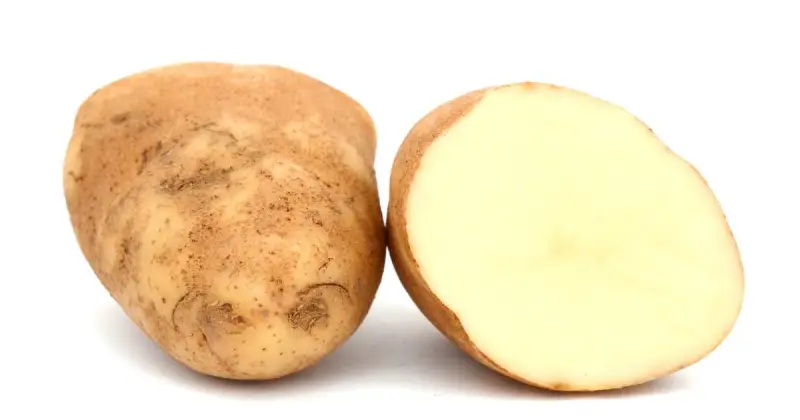
Conclusion
Now that you have a successful plan to cultivate potatoes in containers during winter remember to harvest your mature tubers after flowering and store them in a cool, dark place to prevent sprouting.
As your spuds continue to sprout, monitor soil moisture, protect from frost, and employ organic gardening practices for healthy growth. With proper planning and care, you can enjoy a bountiful harvest of delicious homegrown potatoes even during winter. Who knew gardening could be this much fun?
Have you successfully grown potatoes in winter? We’d love to hear the steps you took to make it happen. You may have used some of the advice in this article or done something else entirely. Leave a comment below and let us know how you did it, along with the regional zone you reside in!
SOURCES
- University Of California, Agriculture And Natural Resources – Potatoes – A Great Winter Crop
- University Of Illinois Urbana-Champaign, College Of Agricultural, Consumer & Environmental Sciences – Potato
- Almanac – How To Grow Potato Plants: The Complete Guide
- Utah State University, Yard And Garden Extension – How To Grow Potatoes In Your Home Garden
- University Of Georgia, Extension – Home Garden Potatoes
- North Carolina State University, Extension – Pests Of Potato
- Royal Horticultural Society – How To Grow Potatoes
- SquareFootGardening – Long Term Storage Of Your SFG Potatoes, Onions, Winter Squash




